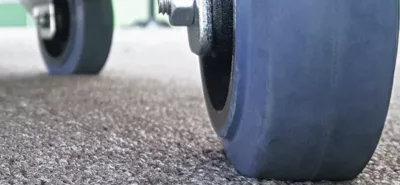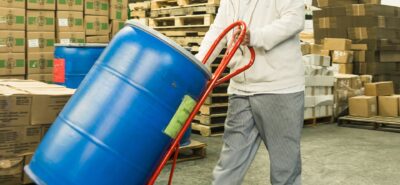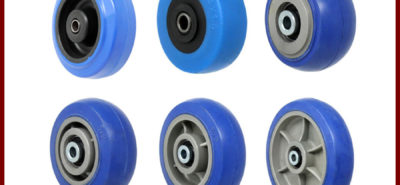Caster Safety and Solutions: How to Ensure Stability and Avoid Risks
Casters are vital for the mobility of various equipment, from industrial machinery to office chairs. While they enhance efficiency, their role in safety is often overlooked.
A malfunctioning or unstable caster can lead to accidents, damaging equipment, and posing risks to individuals. Whether it’s a sudden break, misalignment, or gradual wear and tear, the results of caster failure range from minor disruptions to significant accidents.
This article sheds light on caster safety, the risks of failure, and expert solutions to ensure stability. By understanding caster risks and solutions, you can ensure longevity, and safe usage, while also avoiding unforeseen mishaps.
Why Casters Fail – Risks and Causes
Casters, though small, are complex assemblies of bearings, wheels, and mounts. Their efficiency is dependent on all of these components working in harmony. However, when one component falters, the entire caster can fail.
Here are some industry insights into why casters fail before their time:
Load Capacity Mismatch
Each caster is designed for a specific weight range. Using them beyond this capacity can strain the bearings and lead to premature failure.
Environmental Challenges
In industries where casters are exposed to chemicals, high temperatures, or abrasive materials, the wear is accelerated. Specialized casters are available for such environments, but using standard ones can lead to rapid degradation.
Natural Wear and Tear
Even with perfect usage, the friction between the wheel and the ground, combined with load, causes wear. Over time, this can compromise the caster’s integrity.
The Real-World Consequences of Caster Malfunctions
Beyond the obvious inconvenience, a malfunctioning caster can have serious repercussions.
Here’s what’s at stake:
- In fast-paced environments like warehouses or hospitals, a sudden caster failure can lead to accidents, posing risks to both staff and equipment.
- In manufacturing setups, a single equipment’s downtime due to caster failure can result in delays causing setbacks in entire production lines.
- Heavy machinery or delicate equipment can get damaged if a caster gives way unexpectedly, leading to repair or replacement costs.
Possible Solutions to Caster-Related Risks
Navigating the world of caster safety can be complex, but with the right solutions in place, risks can be significantly reduced. Here’s a comprehensive look at the most effective solutions available:
From our extensive experience in the caster industry, we’ve recognized the undeniable importance of brakes in ensuring safety and efficiency.
Caster Wheels with Brake
Heavy-duty caster wheels with brakes are more than just a convenience. In bustling environments like hospitals or factories, where there’s constant movement and activity, having the ability to securely lock equipment in place is crucial.
It prevents unintentional shifts that could lead to accidents or disrupt operations.
Swivel Caster with Brake
These are the go-to choices for areas requiring frequent maneuvering. The swivel design allows the equipment to change directions seamlessly, and the integrated brake ensures it stays put when stationary.
This combination is especially useful in spaces like warehouses or retail floors, where equipment often needs to navigate around obstacles and then remain stationary for loading or unloading.
Incorporating brakes into caster design is a reflection of the industry’s commitment to enhancing safety without compromising on mobility. As equipment gets heavier and workspaces become more dynamic, the role of brakes in casters will only become more pivotal.

How to Prolong Caster Life: Proactive Measures: Navigating Caster Risks with Expertise
If you have been working with casters as long as we have then you’d know that caster maintenance isn’t just about fixing what’s broken. It’s about proactive care.
Here are some industry-backed recommendations:
- Opt for casters designed for specific environments, especially if they’re exposed to chemicals or high temperatures.
- Rotate casters periodically. Just like car tires, rotating them ensures even wear, prolonging their life.
- Invest in quality. While it might be tempting to opt for cheaper alternatives, high-grade casters often offer better longevity and performance.
A caster’s small stature belies its significance. By understanding the mechanics behind their failures and the real-world implications, one can make informed decisions, ensuring safety and efficiency.
The first step in ensuring the longevity and safety of casters is making the right choice at the outset. It’s not just about size or appearance; it’s about understanding the demands of the environment and the specific needs of the equipment. For instance:
- Floor Conditions – Rough or uneven floors require casters with thicker and more durable wheels. On the other hand, smooth surfaces like tiles or hardwood might benefit from softer wheel materials to prevent scratches.
- Load Dynamics – Static loads (like furniture) and dynamic loads (like moving machinery) have different demands. Ensure the caster is apt for the kind of load it will predominantly handle.
- Specialized Needs – Some industries have unique requirements. For instance, in the food industry, casters need to be resistant to frequent washdowns and potential food particle accumulation.
For a more detailed guide on choosing the perfect caster for your needs, check out our comprehensive guide to choosing the right caster.
Maintenance, Training, and Awareness
While the design and build of casters are crucial, the way they’re handled and maintained by users can significantly impact their efficiency and lifespan. Often, the difference between a caster that lasts a year and one that lasts a decade is maintenance.
Here are some insights:
Regular Cleaning
Especially in environments where casters are exposed to dirt, debris, or sticky substances, regular cleaning can prevent buildup that affects movement. Just like any machinery, casters benefit from regular check-ups. Establish a routine where casters are inspected for signs of wear, damage, or malfunction. Every once in a while, bring in professionals for a thorough inspection. This proactive approach can prevent minor issues from escalating into major problems.
Lubrication
Just like any other moving part, casters benefit from periodic lubrication. Specialized lubricants are available for casters used in high-temperature or food-grade applications.
Alignment Checks
Misaligned casters not only wear out faster but can also cause uneven wear on equipment and floors. Everyone using equipment with casters must understand their proper handling and maintenance.
Regular training sessions can equip staff with the knowledge to use and maintain casters correctly. Periodic awareness campaigns can serve as reminders and updates on best practices, with a special emphasis on the importance of braking systems.
For those keen on ensuring their casters remain in top condition, don’t miss our in-depth Caster Maintenance Guide.

Addressing Common Caster Issues
Even with the best care, casters can face issues. The key is to address them promptly:
- Replace worn-out wheels – Instead of replacing the entire caster, often just the wheel can be replaced, saving costs.
- Tighten loose fittings – Regularly check for any loose fittings or components and tighten them to prevent accidents.
- Replace bearings – Over time, bearings can wear out or get clogged with debris. Replacing them can give the caster a new lease of life.
In conclusion, proactive measures, combined with industry knowledge, can significantly mitigate caster risks. It’s about making informed choices, regular upkeep, and addressing issues head-on.
Investing in Quality and Environment-Specific Solutions
The surroundings in which a caster functions can have a profound effect on its durability and performance. Investing wisely based on these conditions can save costs and enhance safety in the long run.
Not all casters are made equal. Investing in high-quality casters might seem like a bigger upfront cost, but their longevity and reliability often justify the investment.
Different industries and environments have unique challenges. A caster perfect for a carpeted office might not be suitable for a factory floor. Recognizing these specific needs and choosing casters tailored to them can lead to better performance, reduced wear, and fewer accidents. Whether it’s a caster designed for rough terrains or one with a brake system tailored for high-traffic areas, making an informed choice based on the environment is key.
Explore Our Range of Durable Casters
At Castercity we pride ourselves on offering a diverse range of casters tailored to various needs. Whether you’re looking for casters that can withstand extreme temperatures, heavy loads, or specific environmental challenges, we’ve got you covered.
Dive into our collection and find the perfect fit for your requirements. Check out our range of durable casters here.
Conclusion
Understanding caster risks and solutions is a blend of technical knowledge and practical insights. It’s about recognizing the potential challenges and proactively addressing them. With the right choices and regular maintenance, caster failures can be significantly reduced, ensuring safety and efficiency. And remember, whenever in doubt, experts at Castercity.com are just a click away, ready to guide you.
Ready to make the best caster choice for your needs? Or perhaps you’re looking to upgrade? Dive into our extensive collection and find the perfect match.





